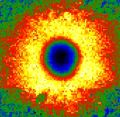Speaker
Description
The nanorod-nanorod contact represents a fundamental element of chemiresistive semiconducting metal oxide nanonetwork-based gas sensors. The enhancement of sensing capabilities is thought to be a consequence of the potential barriers that form at the nanorod-nanorod interface, with the height of the barriers being strongly influenced by the adsorption and desorption of the detected gas. Despite the necessity for a more profound understanding of the characteristics of the barriers to facilitate the design and optimisation of future devices, only a limited number of the papers in the field have investigated this topic in depth.
The present work is therefore focused on the electrical characterisation of the single nanorod-nanorod contact and the understanding of its properties as a basic building block of larger functional units, such as gas sensors. Given our research group’s experience in nanoprobe-based electrical characterisation of one-dimensional and two-dimensional nanosystems [1, 2], we employed two tungsten nanoprobes mounted in the chamber of a multifunctional scanning electron microscope (SEM) equipped with a focused ion beam (FIB) and a gas injection system (GIS), allowing us to measure the current-voltage characteristics of the nanostructures and perform local deposition of conductive Pt contacts. While the nanoprobe approach is advantageous in many ways compared to the usual methods of nanoscale electrical measurements (such as deposition of lithographic contacts), it is important to consider and account for several factors to obtain reliable results.
This presentation will address some of the limitations of this method that were encountered during the measurements of ZnO nanorods with morphology relevant to possible use in gas sensors (large aspect ratio, relatively small diameter). These include the stability of nanoprobe-nanorod contact and the tendency of nanorods to bend under the pressure of contacting nanoprobes, which is associated with the higher elasticity of nanorods with large aspect ratios. It will also discuss the steps that have already been taken to overcome these limitations, or that are planned for implementation in future work. In addition, the preparation of ZnO nanorod samples suitable for these measurements is also addressed.
[1] Stanislav Tiagulskyi, Roman Yatskiv, Hana Faitová, Šárka Kučerová, Jan Vaniš, Jan Grym, Electrical properties of nanoscale p-n heterojunctions formed between a single ZnO nanorod and GaN substrate, Materials Science in Semiconductor Processing, Volume 107, 2020, 104808, ISSN 1369-8001, https://doi.org/10.1016/j.mssp.2019.104808.
[2] Stanislav Tiagulskyi, Ondřej Černohorský, Nikola Bašinová, Roman Yatskiv, Jan Grym, The high thermal conductivity of graphene prevents ZnO nanorod-graphene interface from degradation, Materials Research Bulletin, Volume 164, 2023, 112286, ISSN 0025-5408, https://doi.org/10.1016/j.materresbull.2023.112286.

